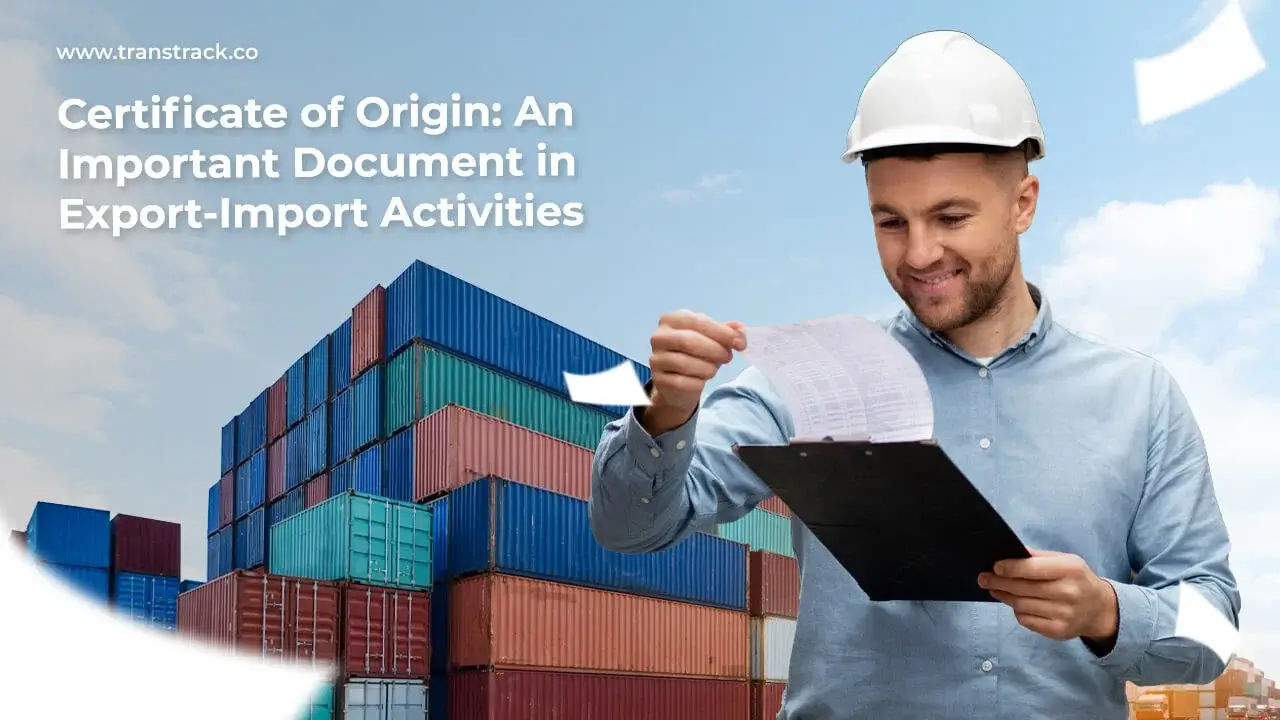Certificate of Origin: An Important Document in Export-Import Activities

Those of you who often export and import goods are certainly familiar with the term Certificate of Origin (CoO). Certificate of Origin is a letter or document that plays an important role in every international trade transaction. For ordinary people who have never done import export goods may wonder what is CoO? What are the functions of CoO?
For that, if you want to know more about CoO, please refer to this article until the end. In this article, TransTRACK has summarized important things related to CoO ranging from understanding, functions, to types. So, let’s get straight to the discussion!
Definition of Certificate of Origin
Certificate of Origin or also known as Surat Keterangan Asal (SKA) in Indonesia, is a document issued by an authorized agency in a country to state the origin of exported goods. CoO serves as written evidence of the country of origin of an exported item.
In general, a CoO is defined as a certificate that states in which country an item was actually produced or processed for the last time before being exported to the country of import. This CoO ensures that the imported or exported goods meet the origin requirements set by certain countries.
Types of Certificate of Origin
Broadly speaking, there are 3 types of Certificate of Origin that are commonly used in international trade, namely:
General Certificate of Origin
General Certificate of Origin is issued for general trade purposes such as customs, banking, and export and import document requirements of a country. This type of CoO is neutral and not related to tariff preference agreements.
Certificate of Origin Preferential
Certificate of Origin Preferential is a special CoO issued under a free trade agreement (FTA) between countries. This CoO is required to obtain preferential import duty rates according to the applicable FTA scheme.
Non-Preferential Certificate of Origin
A Non-Preferential CoO certifies the origin of goods from a particular country, but is not linked to an FTA agreement or other preferential tariff scheme. Non-Preferential CoOs are usually required by importing countries to apply import quotas, trademark protection, dumping considerations, and others.
The Role of CoO in Import-Export of Goods
CoO has a central role in the import-export process. Its function is not only limited to indicating the origin of a product, but also helps governments and businesses to control the flow of international trade. Some of the main roles of CoO include:
Proof of Origin of Goods
One of the main roles of a CoO is to serve as valid proof of origin. It clearly shows which country a product originated from. Understanding the origin of goods is important because some countries apply different tariffs or give certain preferences based on the country of origin.
Supporting Customs Exemptions
CoO plays a role in supporting customs exemptions or preferential tariffs. Some countries provide lower tariffs or even customs exemptions for goods originating from certain countries. The CoO provides the necessary evidence for importers to take advantage of these policies.
Legal Compliance
The use of CoO is a legal requirement in some import-export transactions. Certain countries require this document as part of customs procedures and international trade regulations. Therefore, CoO ensures that the parties involved comply with the applicable legal regulations.
Preventing Trade Fraud
CoO also serves as a tool to prevent trade fraud. By listing valid origin information, this document helps ensure that the goods being traded are genuine and match the promised quality. This builds trust between exporters and importers.
Components of a Certificate of Origin
A Certificate of Origin is not just a statement of origin, but a document that contains several important components. Some of the information that is usually included in it includes:
- CoO Reference Number: This is a unique code or reference number assigned to each CO sheet for identification and authentication purposes by the relevant authorities in the country of exporters and importers.
- Exporter and Importer Information: The CoO also includes complete information about the exporter and importer. This information includes name, address, and contact number.
- Description of Goods: Contains detailed information of exported products including the name of the goods, specifications/type, brand, function/use, material composition, production process, packaging, quantity and unit quantity, and value of goods.
- Origin of Goods: Information indicating the country of origin where the goods were produced or substantially processed in accordance with the origin rule criteria set out in applicable international agreements.
- Type of Carriage and Route: To provide a complete picture of the goods journey, the CoO lists the type of transportation used (land, sea, air) and the route taken.
- Authorized Agency Attestation: Contains the signature, original seal, and attestation phrase of the authorized agency confirming the validity and correctness of the origin of the goods listed in the CO.
With an in-depth understanding of CoOs, businesses can ensure their compliance with international trade regulations. Therefore, a good understanding of what CoO is and how to utilize it effectively is essential in the context of global trade.
For companies or businesses looking to improve and optimize the international trade process, it may be possible to integrate it with the technology offered by TransTRACK, namely Fleet Management System (FMS). FMS enables real-time monitoring of freight transportation fleet movements, ensuring efficiency and reliability of deliveries. With system integration, information regarding the origin and journey of goods recorded in the Certificate of Origin can be accessed easily, minimizing the risk of errors and improving compliance with trade regulations. The technology also facilitates transparency and collaboration between businesses, freight forwarders, and authorities, optimizing the global supply chain as a whole. Thus, the utilization of Fleet Management System not only improves logistics efficiency but also strengthens integrity and traceability in international trade.
Topic





